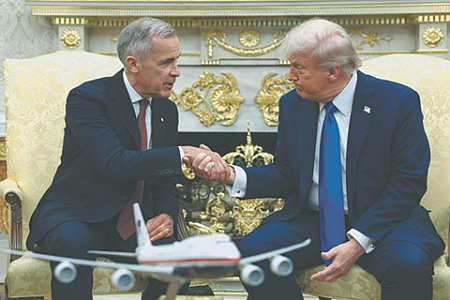
The United States is on the cusp of an unprecedented technological leap in defense, as the deadline for American companies to submit proposals for Donald Trump’s ambitious “Golden Dome” project concludes today, Friday, October 10. This next-generation missile defense system has garnered significant interest from an array of military-technical and high-tech industry giants, all vying for a role in what could redefine global strategic stability. President Trump, following a recent meeting with Canadian Prime Minister Mark Carney at the White House, emphasized the deepening cooperation between Washington and Ottawa on this monumental undertaking.
Dubbed a “comprehensive defense system against all types of missiles,” the Golden Dome aims to establish an impermeable shield over the entire U.S. territory. Its design incorporates ground, sea, and crucially, space-based interceptors, capable of countering ballistic, hypersonic, and cruise missiles, alongside other advanced aerial threats. At the core of this expansive vision is the deployment of a formidable space-based missile defense echelon, signaling a profound shift in military strategy. General Michael Getlein of the U.S. Space Force has been tasked with overseeing this megaproject, with a critical program assessment on the required number of orbital interceptors due in November.
Given the project’s extraordinary complexity and scale, the Pentagon has established a specialized tender mechanism, known as Shield, to facilitate collaboration with potential contractors. Leading defense mainstays like Lockheed Martin, Boeing, Northrop Grumman, Booz Allen Hamilton, and Raytheon, all veterans of previous missile defense programs, have expressed keen interest. They are joined by innovative tech firms such as SpaceX, Anduril, and Palantir, whose expertise in cutting-edge technologies is expected to inject revolutionary elements into the system’s architecture.
The proposed expansion of the “Golden Dome” to include Canada has introduced both a strengthened alliance narrative and a point of contention. President Trump, as quoted by Reuters, highlighted the strategic importance of this joint endeavor amidst a volatile global landscape, describing it as a protective mechanism that even Ronald Reagan could only dream of. However, while Ottawa has allocated nearly $40 billion towards modernizing its missile defense, potentially integrating it into the “Golden Dome,” Trump has provocatively stated that Canada would need to contribute $61 billion for full integration. In a moment that underscored the transactional nature of his foreign policy, he also quipped about defending Canada for free if it were to become the 51st U.S. state. Despite these fiscal and rhetorical hurdles, active discussions between military officials from both nations continue, driven by a shared perception of “growing threats,” as articulated by Royal Canadian Air Force Commander Major General JD Smith.
The sheer financial magnitude and ambitious timeline of the Golden Dome project are subjects of intense scrutiny. While President Trump has earmarked $175 billion for its realization, with the first test slated for autumn 2028, independent assessments paint a far more costly and protracted picture. The U.S. Congressional Budget Office estimates that the development and launch of space-based interceptors alone could reach approximately $524 billion. Industry experts are even more conservative, projecting an overall cost of $831 billion and a two-decade timeline for full implementation, raising serious questions about the project’s feasibility under the current aggressive schedule.
Internationally, the “Golden Dome” has already ignited significant concerns, particularly in Moscow and Beijing. A joint statement issued by Russian President Vladimir Putin and Chinese President Xi Jinping on May 8 explicitly labeled the program as “deeply destabilizing.” Both nations view the project, with its direct provisions for a substantial increase in space-based warfare capabilities and orbital interceptor deployment, as transforming outer space into an arena for weaponization and armed confrontation, potentially sparking a new extraterrestrial arms race.
Vasily Klimov, a research fellow at the Center for International Security at IMEMO RAS, suggests that the “Golden Dome” serves primarily as a political and propaganda maneuver by the Trump administration, designed to project an image of resolve and secure global technological leadership in military development. Klimov argues that the proposed multi-layered missile defense system is too grandiose for easy, unobstructed implementation within the stated timeframe. He anticipates that practical realization might be limited to consolidating existing missile and air defense components with ground and space-based target detection and tracking infrastructure. This monumental project, while fitting the White House’s “peace through strength” doctrine, risks remaining merely a symbolic artifact of the Trump era should it fail to deliver substantial military-technical capabilities.
The unfolding saga of the “Golden Dome” is thus poised to profoundly influence the trajectory of global strategic stability. Experts like Klimov foresee Russia responding by advancing its offensive capabilities, specifically developing systems capable of overcoming missile defenses, even as it advocates for measures promoting transparency, trust, and limitations on missile defense systems within potential strategic arms reduction treaties. Ultimately, the future of the “Golden Dome” will largely dictate the agenda for any prospective U.S.-Russian dialogue on strategic stability, underscoring its pivotal role in shaping the complex dynamics of 21st-century international relations.
